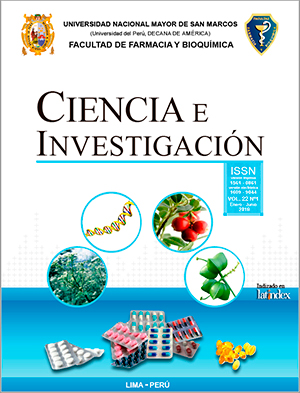Acute Toxicity Bioassay Of Desmodium Molliculum (H.B.K.) D.C. Manayupa
DOI:
https://doi.org/10.15381/ci.v22i1.16813Keywords:
Desmodium molliculum (H.B.K.), acute toxicity, plant extractsAbstract
Objective: To evaluate acute oral toxicity by the method of the decoction classes of the aqueous extract of leaves and stems of Desmodium molliculum (H.B.K.) D.C., manayupa (EAM), at a maximum concentration of 2000 mg / kg body weight. Biological material: Leaves and stems of Desmodium molliculum, manayupa and Mus musculus strain Balb / c / CNPB, adult male and female mice. Methodology: The leaves and stems of Desmodium molliculum, manayupa collected in La Encañada-Cajamarca were desiccated and crushed to 1.5 mm, subjected to a hot aqueous extraction, filtered and concentrated by lyophilization. The acute oral toxicity study was performed using doses of 500, 1000 and 2000 mg / kg bw, respectively. The observations made were recorded that were aimed at the determination of: signs and symptoms of toxicity, weight, death and time of occurrence of the same on days 1, 7 and 14. Results: Under the conditions of the trial, the manayupa did not produce manifestations of symptoms indicative of toxicity, or mortality in mice, no significant changes in body weight were observed. Conclusions: The oral administration for 14 days of the aqueous extract of leaves and stems of Desmodium molliculum (HBK) DC, manayupa, at concentrations up to 2000 mg / kg bw of Mus musculus strain Balb / c / CNPB, mice, is not toxic and it is framed between the “unclassified” substances in the animal model and the dose level used under the experimental conditions observed.
Downloads
Published
Issue
Section
License
Copyright (c) 2019 Gloria Gordillo, Pablo Bonilla, Haydee Zúñiga, Gustavo Guerra, Luz Hernández, Gabriela Solano, Miriam Bazalar

This work is licensed under a Creative Commons Attribution-NonCommercial-ShareAlike 4.0 International License.
LOS AUTORES RETIENEN SUS DERECHOS:
- Los autores retienen sus derechos de marca y patente, y tambien sobre cualquier proceso o procedimiento descrito en el artículo.
- Los autores retienen el derecho de compartir, copiar, distribuir, ejecutar y comunicar públicamente el articulo publicado en la Revista Ciencia e Investigación (por ejemplo, colocarlo en un repositorio institucional o publicarlo en un libro), con un reconocimiento de su publicación inicial en la Revista Ciencia e Investigación.
- Los autores retienen el derecho a hacer una posterior publicación de su trabajo, de utilizar el artículo o cualquier parte de aquel (por ejemplo: una compilación de sus trabajos, notas para conferencias, tesis, o para un libro), siempre que indiquen la fuente de publicación (autores del trabajo, revista, volumen, numero y fecha).






